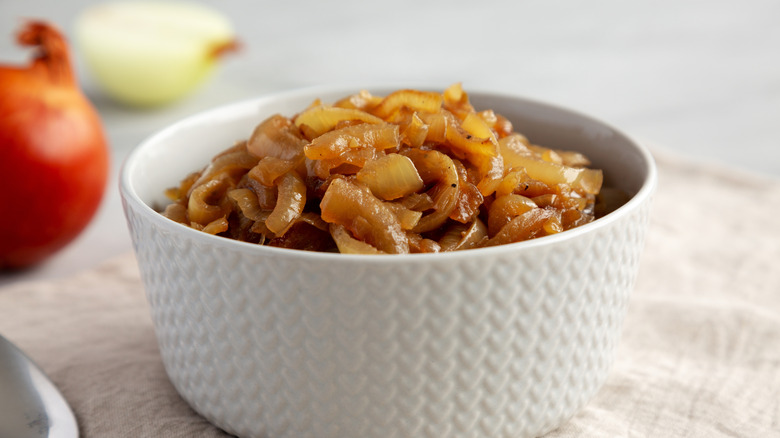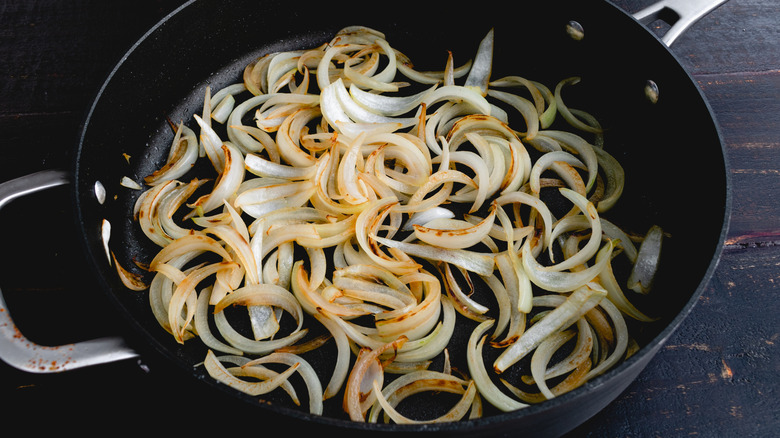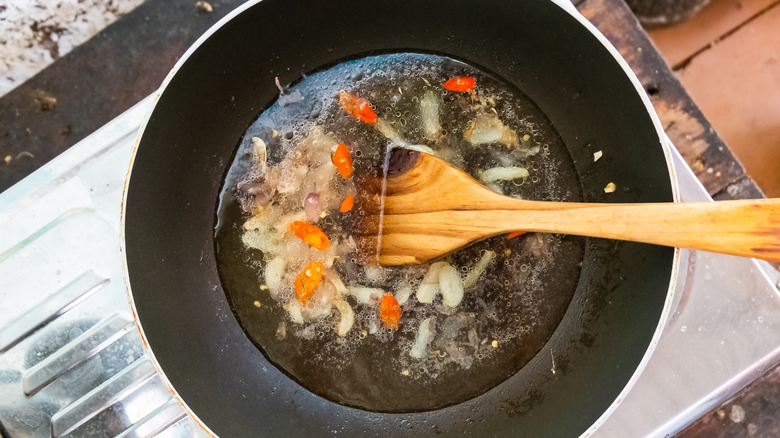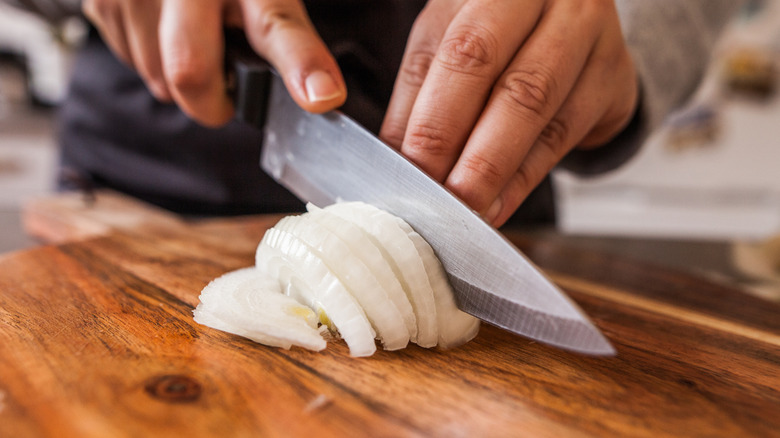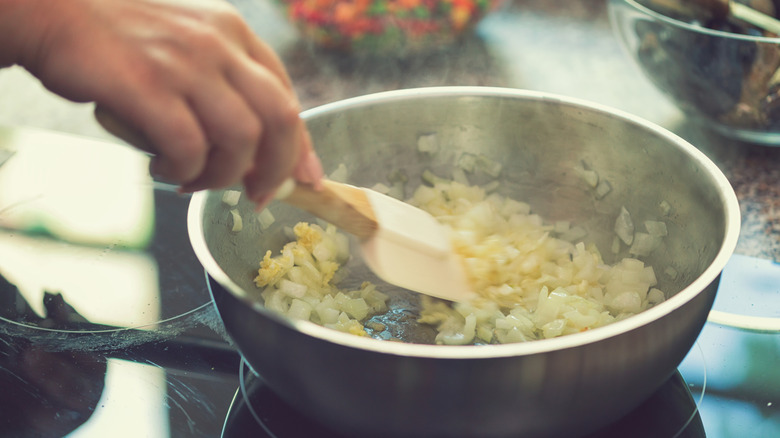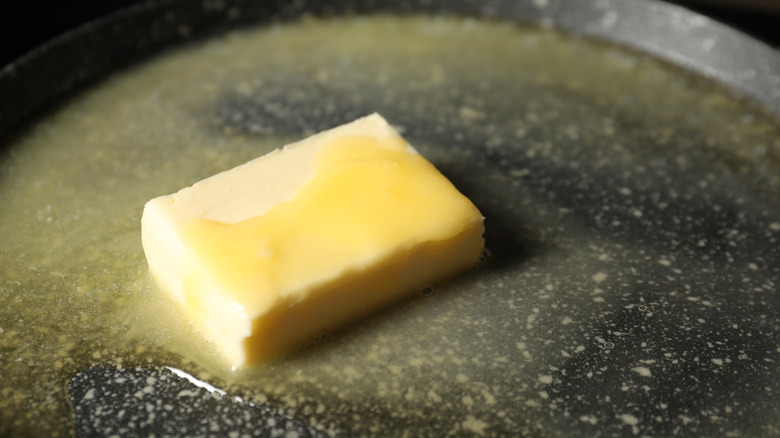5 Simple Tricks To Keep Onions From Burning
Onions are the unsung hero of most kitchens. An unpeeled onion can sit idly in your produce basket for quite some time, waiting to be peeled open for its flavor-packed layers to be put to good use. They are reliable for an easy burst of dynamic flavor, and depending on how you prepare them, onions can affect a dish in several different ways. Two of the most common ways to prepare an onion are sautéing or caramelizing, both of which soften its texture and condense its flavor. But because onions have a high sugar content, and sugar easily burns, both of these cooking methods risk burnt onions.
In other words, onions are easy to burn. And once a small sliver of onion starts to burn, the whole pan is likely going to turn out tasting burnt. However, with a close eye and an even closer spatula, there are easy ways to prevent cooked onions from burning in the pan. With these tricks, you won't be crying over burnt onions — just sliced ones.
Low and slow cooking is the way
The easiest method to keep onions from burning is to cook them low and slow. "Low" refers to the heat, and "slow" refers to the cooking time — which is to say, let them slowly cook over medium-low heat. No matter how you chop your onions, the slices will typically be quite thin. When you set thin onion slices over a ripping fire, they will burn before getting a chance to cook.
A lower heat allows the onions to endure the various stages of cooking intact. When onions hit the heat, the cooking process begins as their water content evaporates. Then, the fat they are cooking in locks in their flavor. The sugars break down and gradually start to caramelize. Setting the onions over a mellow heat eases this process and encourages them to slowly cook before burning entirely. While this method may take some time, it's essential to achieving a desirable result.
Add a bit of water to the pan
When slices of an onion first meet a stove's heat, their water begins to dissipate. Once the water is evaporated, the onion begins to cook exponentially faster. If you notice your heat is too high and the onions are cooking faster than they should be, which leads to burning, lower the heat and add some water to the pan. Lowering the heat is essential, as it inhibits splatter and will allow the water to work its way back into the onions. The water rehydrates the onions and slows their cooking process, stopping them from burning. Adding too much water drowns the onions, whereas adding not enough doesn't do anything.
Depending on the recipe in which you incorporate the onions, add a more flavorful liquid to both slow the cooking process while adding more flavor via deglazing. For instance, consider adding a dry wine — which is the ideal kind of wine for cooking — or a meat broth to complexify the taste of the onions. Regardless of the liquid you add, turn the heat down first to let the deglazing liquid slowly evaporate into a flavorful reduction.
Make sure the slice is right
A lot of cooking comes down to common sense. The smaller or thinner something is, the faster it cooks — and, in turn, the quicker it burns. An onion's layers are already thin, making it more likely to burn quickly. So, when sautéing or caramelizing onions, make sure to not cut the slices too thin. If the slices are too small, the water will evaporate almost immediately, leading to burnt onions. However, if a recipe calls for cooked diced onions, adjust your heat and cooking time to the size of the onion. When cooking small pieces of onion, set them over an even lower heat for a longer period of time. Larger slices with more surface area, on the other hand, can withstand slightly higher temperatures.
Overall, when possible, try to keep the slivers of sautéed onions as reasonably sized as possible. Depending on the desired size and shape of the cooked onions, adjust the stove temperature to ensure an even, burn-free cook.
It's best to let your onions sweat
You may have heard or read the word "sweat" in some recipes. While most of us do not want sweat anywhere near our food, sweating food refers to cooking it slowly to allow the water content to evaporate. When onions sweat, their fibers soften and the onions cook into a browned caramelization. Letting onions sweat before they begin to cook is crucial for a perfectly sautéed or caramelized batch. Onions need to release their water content before the flavors can begin to develop. In order to encourage sweating, distribute the heat evenly by stirring the onions frequently while over heat.
If you keep onions stagnant over heat without agitating them, only the pieces on the bottom of the pan will be receiving heat which means they will very likely burn before any of the other onions have even started to cook. To make sure they cook thoroughly, stir the onions as they sweat. Once they begin to caramelize, you can let them cook without too much agitation, but an occasional stir is still helpful.
Choose the best fat for the job
Most people choose to sauté their onions in either butter or oil, but a mixture of both is ideal since the combination has a higher smoking point. The dairy in butter causes it to burn easily, so mixing it with oil is best to keep the onions from doing the same.
Apart from which fat you choose, the amount of oil you add to the pan also affects how the onions cook. Not enough will cause them to burn almost instantly as they'll have no substance in which they can cook. However, too much fat, which is highly conductive to heat, causes the onions to fry, making them more vulnerable to high temperatures and burning. For softer caramelized onions, limit the amount of oil because less oil means the onions can slowly break down to a pleasant consistency. For a rugged caramelization, increase the oil to initiate some frying.
